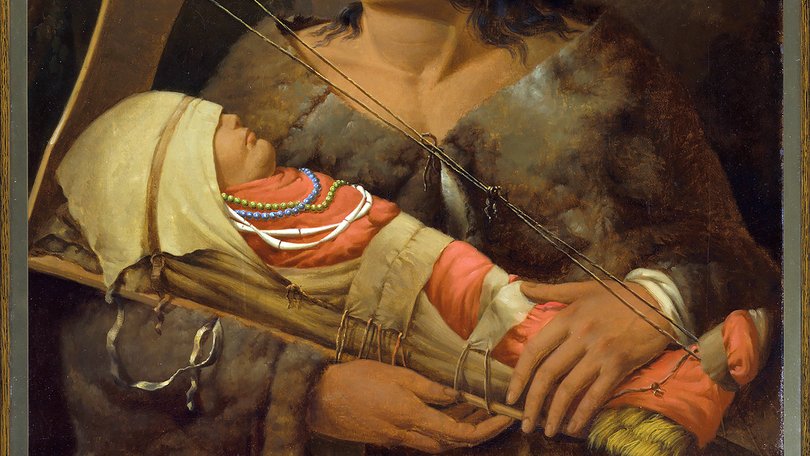THE NEW YORK TIMES: Was head-binding an ancient way to get a leg up?

Parents have been meddling with their children’s heads, if not their minds, since prehistoric times. To achieve the desired forms — flat, round, conical — the pliable skulls of new-borns were typically either wrapped tightly in cloth or bound between boards.
The origins of this practice, known as artificial cranial deformation, have been traced to early Homo sapiens in Australia about 13,000 years ago, and, amid some scholarly contention, potentially to Neanderthal populations 45,000 years ago.
The practice has been documented on every continent except Antarctica. In the region that is now Peru, early inhabitants apparently believed that a sloping forehead was an advantageous feature, with the earliest evidence dating back to the fourth millennium BC.
Sign up to The Nightly's newsletters.
Get the first look at the digital newspaper, curated daily stories and breaking headlines delivered to your inbox.
By continuing you agree to our Terms and Privacy Policy.The stretched, sloped skulls found among the remains of the Paracas culture (active from roughly 800 B.C. to A.D. 100) have even fueled the fanciful idea of an unearthly origin.
“Paracas skulls conform to stereotypical images of aliens in 20th-century pulp science fiction,” said Matthew Velasco, an anthropologist at Cornell University. “In other words, modern artists made head shape into something extra-terrestrial, which seems like a pretty flimsy basis to argue for space alien influence on ancient societies.”
In his new book, “The Mountain Embodied,” Velasco details the cranial modification traditions of the Collaguas and Cavanas, neighbouring peoples that lived in the Colca Valley of highland Peru.
During the Late Intermediate Period, from about 1100 to 1450, the Collaguas employed methods to make their heads assume a longer, narrower shape, while the Cavanas sought to make their heads wide and squat. Over time, the Collaguas’ elongated look became the dominant style of cranial modification in the valley.
These deliberate alterations resulted in craniums that mimicked the silhouettes of mountains sacred to their respective cultures.
Velasco quotes a 16th-century Spanish scribe and translator who wrote that the Collaguas wore tall, brimless hats called chucos and fashioned head shapes to pay homage to Collaguata, the distant volcano that they considered their ancestral home.
The Cavanas, the translator observed, sculpted the skulls of their babies in tribute to Gualcagualca, the snow laden peak that loomed over their town.
Andean head-shaping has traditionally been viewed as a way to visually distinguish different ethnic groups, similar to the way Han Chinese foot-binding was perceived.
Velasco’s book argues for a shift toward understanding it from the perspective of the people who practiced it.
Instead of seeing head-shaping solely as a trait that marked insider and outsider, he suggests that the custom may also have held a deeper meaning for those within the Andean culture.
“Dr. Velasco’s book pushes against the colonial invention that head shape was a mere ethnic marker,” said Andrew Scherer, an anthropologist at Brown. “Instead, he points to more subtle matters of personhood, belief and tradition.”
To Velasco, personhood is not simply an inherent aspect of being human, but a quality that empowers individuals, places or things to fully partake in social affairs, and in Andean societies, this was not predetermined.
“Sacred mountains and objects could be fully interacted with as people,” Velasco said. “Mountains particularly were thought of as vital participants in society, and, as anthropologists, we take that idea seriously, even if it seems strange.”
In a 2018 study, Velasco examined the skulls of 213 once-mummified humans buried in two Collagua cemeteries.
Based on skeletal analyses, he theorized that cranially modified Collagua girls and women may have benefited from a more privileged existence, with better access to a wider range of foods and a lower incidence of violence.
By the 15th century, the Incas had assimilated the valley into their empire. While they permitted head-shaping among the locals, recent scholarship indicates that the Incas did not adopt it.
The Spanish invaders outlawed the tradition in the 16th century — first by order of Francisco de Toledo, Viceroy of Peru, in 1573, and a decade later by the Third Council of Lima, which specifically described women performing the procedure.
In his book, Velasco argues that the practice of head-binding contributed to social disparities. Individuals with bound heads were likely to assume specific roles in the farming and herding economy, roles that later conferred entitlements to land and resources.
Consequently, the broad adoption of head-shaping in the 14th century appears to have, perhaps unintentionally, served to maintain wealth within these groups.
Medical research has shown that altering a new-born’s skull shape, when the bones are malleable and the soft spots, or fontanels, are open, was unlikely to have negatively affected cognitive development.
“There’s simply no evidence that shows cranial modification caused neurological damage,” Velasco said. The brain, being adaptable, maintains its volume — and functionality — despite changes made to the cranium’s shape.
Velasco noted that cranial orthosis, or “helmet therapy,” a modern method for gently reshaping a baby’s head, is not so different from 15th-century Andean skull molding, despite the vastly different cultural landscapes involved. In both cases, he said, the underlying motivation was a parental wish that their children conform to a bodily standard.
“No one would deny that children are highly moldable,” Velasco said. “It’s just that some people and societies are more conspicuous in the way they shape their kids.”
This article originally appeared in The New York Times.
© 2025 The New York Times Company
Originally published on The New York Times
